ESP YAMAHA YZF-R6 2000 Owners Manual
[x] Cancel search | Manufacturer: YAMAHA, Model Year: 2000, Model line: YZF-R6, Model: YAMAHA YZF-R6 2000Pages: 111, PDF Size: 11.91 MB
Page 35 of 111
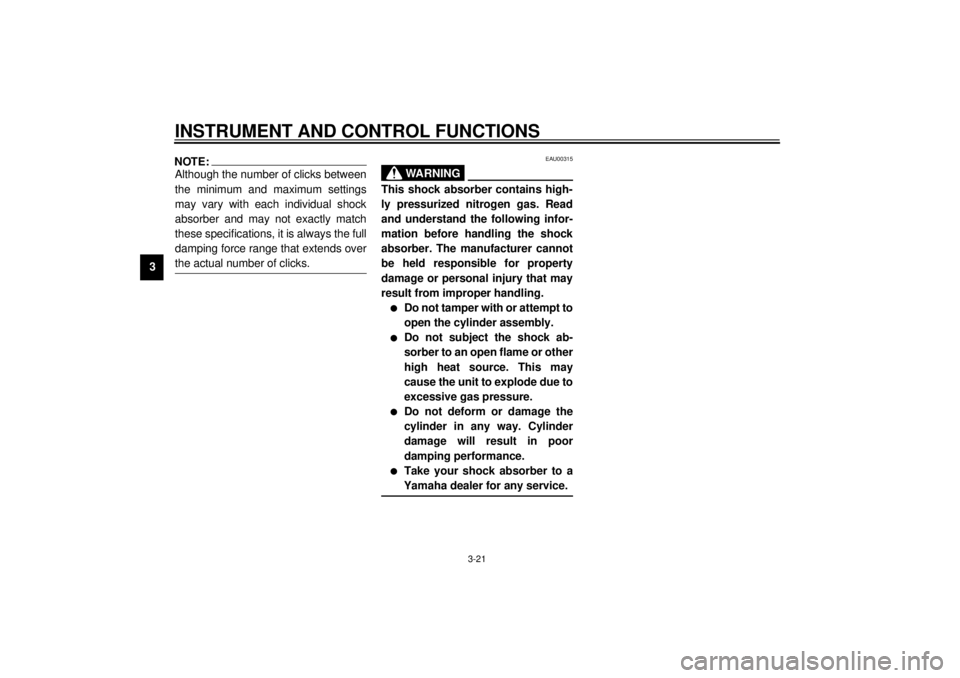
INSTRUMENT AND CONTROL FUNCTIONS
3-21
3
NOTE:@ Although the number of clicks between
the minimum and maximum settings
may vary with each individual shock
absorber and may not exactly match
these specifications, it is always the full
damping force range that extends over
the actual number of clicks. @
EAU00315
WARNING
@ This shock absorber contains high-
ly pressurized nitrogen gas. Read
and understand the following infor-
mation before handling the shock
absorber. The manufacturer cannot
be held responsible for property
damage or personal injury that may
result from improper handling.l
Do not tamper with or attempt to
open the cylinder assembly.
l
Do not subject the shock ab-
sorber to an open flame or other
high heat source. This may
cause the unit to explode due to
excessive gas pressure.
l
Do not deform or damage the
cylinder in any way. Cylinder
damage will result in poor
damping performance.
l
Take your shock absorber to a
Yamaha dealer for any service.
@
E_5eb_Functions.fm Page 21 Thursday, November 18, 1999 4:03 PM
Page 36 of 111
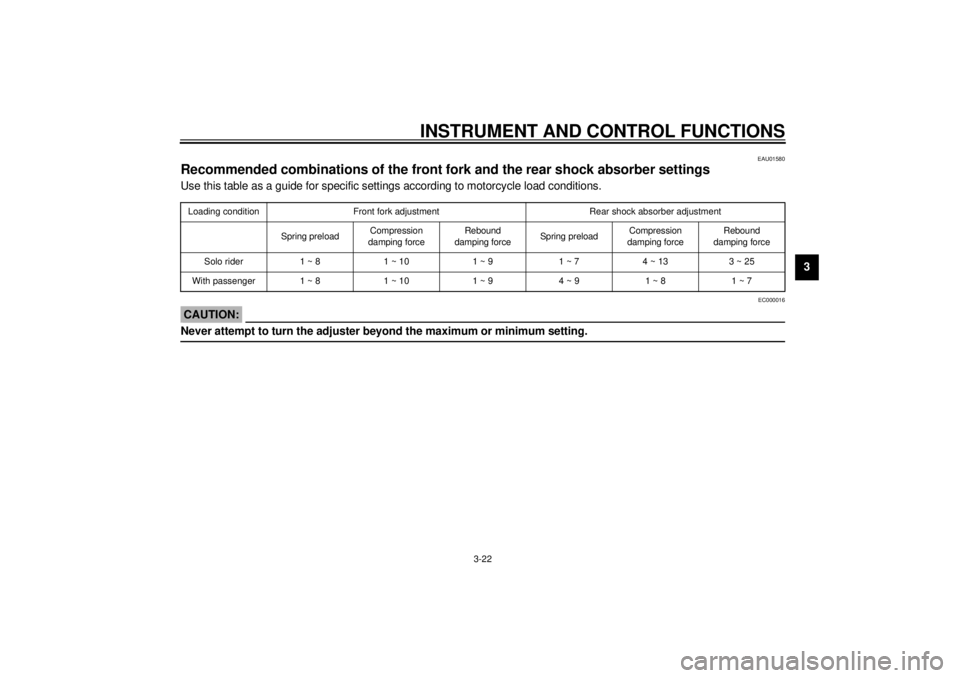
INSTRUMENT AND CONTROL FUNCTIONS
3-22
3
EAU01580
Recommended combinations of the front fork and the rear shock absorber settingsUse this table as a guide for specific settings according to motorcycle load conditions.CI-31E
EC000016CAUTION:@ Never attempt to turn the adjuster beyond the maximum or minimum setting. @Loading condition Front fork adjustment Rear shock absorber adjustment
Spring preload Compression
damping forceRebound
damping forceSpring preloadCompression
damping forceRebound
damping force
Solo rider 1 ~ 8 1 ~ 10 1 ~ 9 1 ~ 7 4 ~ 13 3 ~ 25
With passenger 1 ~ 8 1 ~ 10 1 ~ 9 4 ~ 9 1 ~ 8 1 ~ 7
E_5eb_Functions.fm Page 22 Thursday, November 18, 1999 4:03 PM
Page 41 of 111

4-1
4
EAU01114
4-PRE-OPERATION CHECKSOwners are personally responsible for their vehicle’s condition. Your motorcycle’s vital functions can start to deteriorate
quickly and unexpectedly, even if it remains unused (for instance, if it is exposed to the elements). Any damage, fluid leak or
loss of tire pressure could have serious consequences. Therefore, it is very important that, in addition to a thorough visual in-
spection, you check the following points before each ride.
EAU00340
PRE-OPERATION CHECK LIST
ITEM CHECKS PAGE
Front brake
• Check operation, free play, fluid level and fluid leakage.
• Fill with DOT 4 brake fluid if necessary.6-25 ~ 6-28
Rear brake6-25 ~ 6-28
Clutch• Check operation condition and free play.
• Adjust if necessary.6-25
Throttle grip and housing• Check for smooth operation.
• Lubricate if necessary.6-21, 6-30
Engine oil• Check oil level.
• Fill with oil if necessary.6-10 ~ 6-13
Coolant reservoir tank• Check coolant level.
• Fill with coolant if necessary.6-13 ~ 6-16
Drive chain• Check chain slack and condition.
• Adjust if necessary.6-28 ~ 6-29
Wheels and tires• Check tire pressure, wear and damage.6-21 ~ 6-24
6-37 ~ 6-40
Control cable• Check for smooth operation.
• Lubricate if necessary.6-30
Brake pedal shaft• Check for smooth operation.
• Lubricate if necessary.6-30
Brake and clutch lever
pivots• Check for smooth operation.
• Lubricate if necessary.6-31
E_5eb_Preop.fm Page 1 Thursday, November 18, 1999 4:05 PM
Page 47 of 111
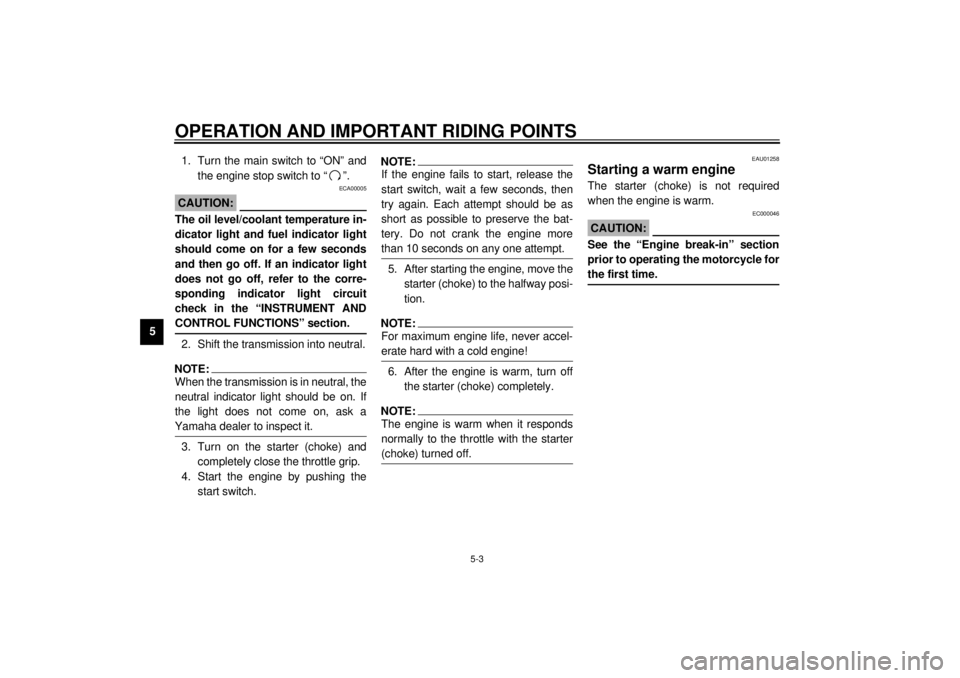
OPERATION AND IMPORTANT RIDING POINTS
5-3
51. Turn the main switch to “ON” and
the engine stop switch to “ ”.
ECA00005
CAUTION:@ The oil level/coolant temperature in-
dicator light and fuel indicator light
should come on for a few seconds
and then go off. If an indicator light
does not go off, refer to the corre-
sponding indicator light circuit
check in the “INSTRUMENT AND
CONTROL FUNCTIONS” section. @2. Shift the transmission into neutral.NOTE:@ When the transmission is in neutral, the
neutral indicator light should be on. If
the light does not come on, ask a
Yamaha dealer to inspect it. @3. Turn on the starter (choke) and
completely close the throttle grip.
4. Start the engine by pushing the
start switch.
NOTE:@ If the engine fails to start, release the
start switch, wait a few seconds, then
try again. Each attempt should be as
short as possible to preserve the bat-
tery. Do not crank the engine more
than 10 seconds on any one attempt. @5. After starting the engine, move the
starter (choke) to the halfway posi-
tion.NOTE:@ For maximum engine life, never accel-
erate hard with a cold engine! @6. After the engine is warm, turn off
the starter (choke) completely.NOTE:@ The engine is warm when it responds
normally to the throttle with the starter
(choke) turned off. @
EAU01258
Starting a warm engineThe starter (choke) is not required
when the engine is warm.
EC000046
CAUTION:@ See the “Engine break-in” section
prior to operating the motorcycle for
the first time. @
E_5eb_Operation.fm Page 3 Thursday, November 18, 1999 4:05 PM
Page 70 of 111
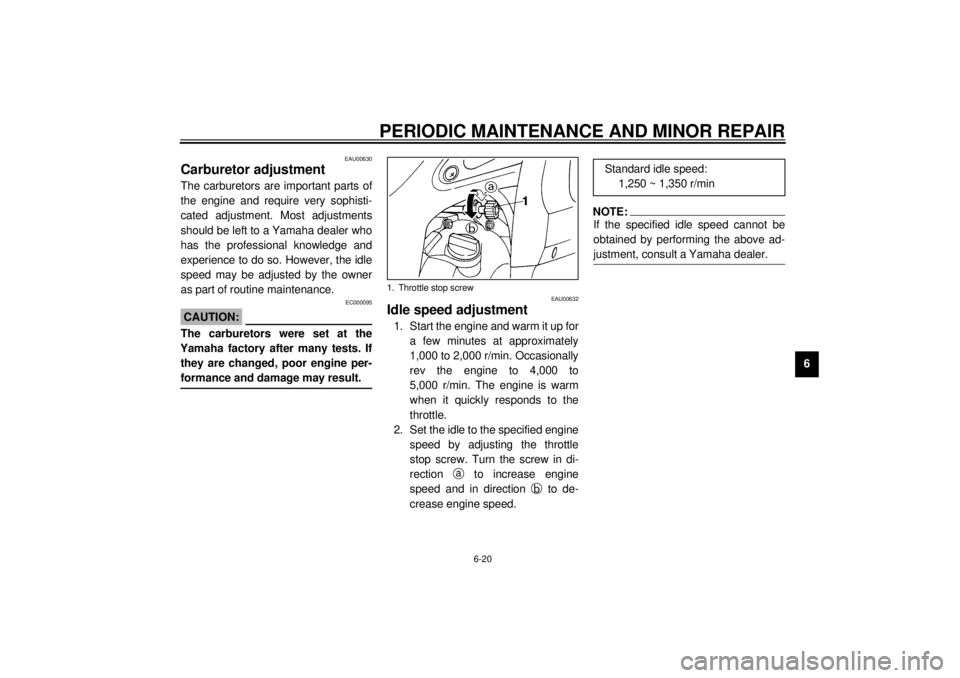
PERIODIC MAINTENANCE AND MINOR REPAIR
6-20
6
EAU00630
Carburetor adjustmentThe carburetors are important parts of
the engine and require very sophisti-
cated adjustment. Most adjustments
should be left to a Yamaha dealer who
has the professional knowledge and
experience to do so. However, the idle
speed may be adjusted by the owner
as part of routine maintenance.
EC000095
CAUTION:@ The carburetors were set at the
Yamaha factory after many tests. If
they are changed, poor engine per-
formance and damage may result. @
EAU00632
Idle speed adjustment1. Start the engine and warm it up for
a few minutes at approximately
1,000 to 2,000 r/min. Occasionally
rev the engine to 4,000 to
5,000 r/min. The engine is warm
when it quickly responds to the
throttle.
2. Set the idle to the specified engine
speed by adjusting the throttle
stop screw. Turn the screw in di-
rection
a to increase engine
speed and in direction
b to de-
crease engine speed.
NOTE:@ If the specified idle speed cannot be
obtained by performing the above ad-
justment, consult a Yamaha dealer. @
1. Throttle stop screw
Standard idle speed:
1,250 ~ 1,350 r/min
E_5eb_Periodic.fm Page 20 Thursday, November 18, 1999 4:06 PM
Page 96 of 111
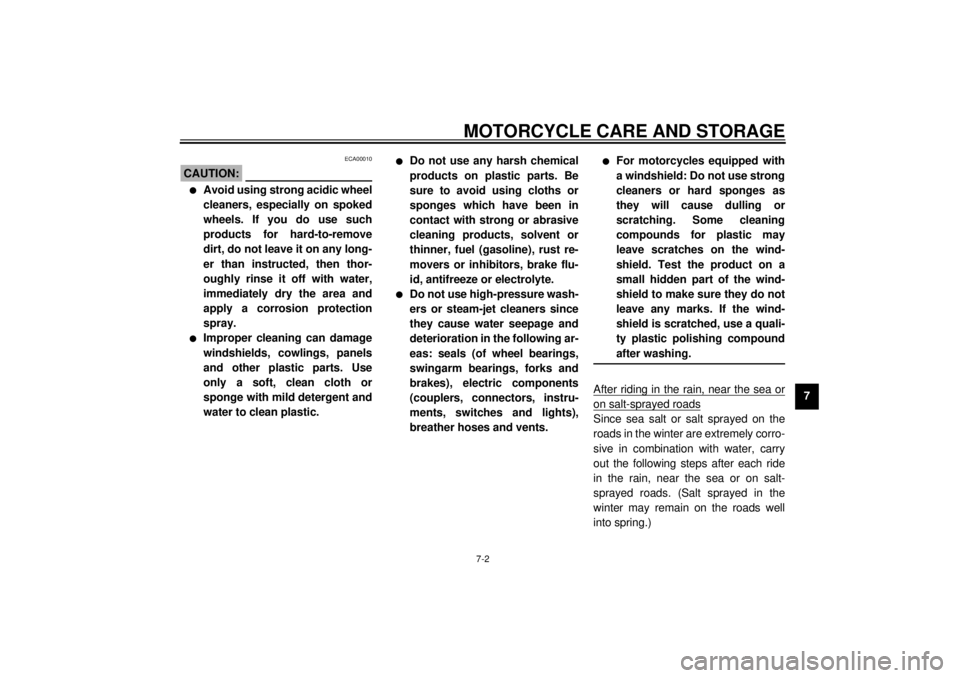
MOTORCYCLE CARE AND STORAGE
7-2
7
ECA00010
CAUTION:@ l
Avoid using strong acidic wheel
cleaners, especially on spoked
wheels. If you do use such
products for hard-to-remove
dirt, do not leave it on any long-
er than instructed, then thor-
oughly rinse it off with water,
immediately dry the area and
apply a corrosion protection
spray.
l
Improper cleaning can damage
windshields, cowlings, panels
and other plastic parts. Use
only a soft, clean cloth or
sponge with mild detergent and
water to clean plastic.
l
Do not use any harsh chemical
products on plastic parts. Be
sure to avoid using cloths or
sponges which have been in
contact with strong or abrasive
cleaning products, solvent or
thinner, fuel (gasoline), rust re-
movers or inhibitors, brake flu-
id, antifreeze or electrolyte.
l
Do not use high-pressure wash-
ers or steam-jet cleaners since
they cause water seepage and
deterioration in the following ar-
eas: seals (of wheel bearings,
swingarm bearings, forks and
brakes), electric components
(couplers, connectors, instru-
ments, switches and lights),
breather hoses and vents.
l
For motorcycles equipped with
a windshield: Do not use strong
cleaners or hard sponges as
they will cause dulling or
scratching. Some cleaning
compounds for plastic may
leave scratches on the wind-
shield. Test the product on a
small hidden part of the wind-
shield to make sure they do not
leave any marks. If the wind-
shield is scratched, use a quali-
ty plastic polishing compound
after washing.
@After riding in the rain, near the sea oron salt-sprayed roadsSince sea salt or salt sprayed on the
roads in the winter are extremely corro-
sive in combination with water, carry
out the following steps after each ride
in the rain, near the sea or on salt-
sprayed roads. (Salt sprayed in the
winter may remain on the roads well
into spring.)
E_5eb_Cleaning.fm Page 2 Thursday, November 18, 1999 4:08 PM